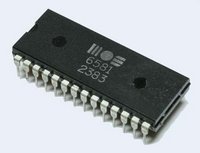 I was lucky enough to receive a Commodore 64 for Christmas one year, I think it was 1989. The C64 had already been around for quite a few years, and my second hand “breadbin” came with literally hundred of games, how chuffed was I? I did once give music making a go on the C64, but it wasn’t very impressive (plus I wasn’t talented or patient enough back then)
I was lucky enough to receive a Commodore 64 for Christmas one year, I think it was 1989. The C64 had already been around for quite a few years, and my second hand “breadbin” came with literally hundred of games, how chuffed was I? I did once give music making a go on the C64, but it wasn’t very impressive (plus I wasn’t talented or patient enough back then)
A few years later I sold it in order to get a Commodore Amiga A500. It was the Amiga which first got me into music production via the amazing Tracker series of software (ProTracker, SoundTracker and NoiseTracker). The Amiga could play back 8-bit digital audio through 4 audio channels at the same time, something pretty amazing at the time. You made music by sequencing short audio samples and playing them back at different pitches to build up your song. Pretty intimidating, but after a few hours you kind of get the hang of it.
![]() To round this flash back up, I eventually moved on to PC tracking, then MIDI sequencing with Cubase, which as you all know uses hardware MIDI modules, or VSTi “Virtual Instruments”.
To round this flash back up, I eventually moved on to PC tracking, then MIDI sequencing with Cubase, which as you all know uses hardware MIDI modules, or VSTi “Virtual Instruments”.
So, how amusing it is that I’ve now gone full circle and am back to the C64 again. Why? Because of a little chip inside which we all lovingly call SID.
SID is a very basic sound chip, it’s not (strictly speaking) capable of digital audio playback, it simply has two oscillators on board capable of making beeps and boops. The creative and programmatic genius of the coders at the time resulted in some pretty great sounds and catchy soundtracks. The likes of Rob Hubbard, Ben Daglish and Martin Galway will always be some personal heros of mine due to their amazing compositions which still sound good today.
The fact that the Commodore 64s SID chip was, in essence, a real mono synth, it what makes it so interesting today. The final SID chips produced were recently snapped up by entrepreneurs behind SID based hardware synthesizers, such as the SIDStation. This means that to make a SID based synth today, you have to harvest SID chips from a real C64 and use them in a kit such as the MIDIBox. This means that C64s are become quite a popular purchase from EBay.
 It seems a shame to steal the SID from a working piece of history, so it’s very exiting to learn that there is now another option : the MSSIAH.
It seems a shame to steal the SID from a working piece of history, so it’s very exiting to learn that there is now another option : the MSSIAH.
In a nutshell, the MSSIAH is five music applications and a MIDI interface all inside a single ROM cartridge which plugs into the C64 expansion port. Being ROM means that the MSSIAH menu loads within 2 seconds of powering on the C64 and the applications themselves take less than 15 seconds to load. So no waiting 5 or 15 minutes for a floppy disk or cassette tape to load!
I’ll explain some more about the MSSIAH in my next post.

It has three oscillators/voices 🙂